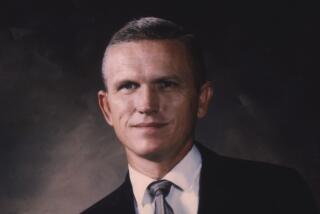Astronomer refined vision above the atmosphere
- Share via
Astronomer Frank J. Low, the experimental genius who developed and distributed sensors for infrared astronomy and performed the first successful observations above the Earth’s atmosphere, died June 11 in Tucson after a long illness, the University of Arizona announced. He was 75.
One of the fathers of infrared astronomy, Low “basically unlocked problems such as how stars form, led to the first observations of light from extrasolar planets and totally revolutionized our view of the energetics and evolution of galaxies,” said Jet Propulsion Laboratory astronomer Michael Werner, project scientist on NASA’s Spitzer Space Telescope.
Low “not only had tremendous technical insight that resulted in huge leaps [in astronomy], but he also founded a company where he sold the very latest astronomical equipment he could figure out how to build,” said astronomer George H. Rieke, a longtime colleague at the University of Arizona. “Sometimes he gave it away.”
A physicist by training, Low essentially entered astronomy at a time when $100-million instruments were not necessary to make new discoveries.
Working at Texas Instruments in 1961, Low developed a gallium-doped semiconductor that could measure very low temperatures by changes in its electrical resistance. He recognized that the thermometer could also serve as a sensitive detector, or bolometer, for an infrared telescope at wavelengths that were too short to be detected with existing telescopes. All objects in the universe emit heat, and he reasoned that an infrared detector could reveal many celestial objects that would otherwise remain unseen.
He took a prototype bolometer to the National Radio Astronomy Laboratory in Green Bank, W.Va., in 1962 and demonstrated it successfully. But there was a problem. Infrared or IR radiation is absorbed by water vapor in the atmosphere, so very little of it actually reaches ground-based detectors. Using a ground-based observatory, Low and graduate student Doug Kleinmann discovered what is now known as the Kleinmann-Low Nebula, which is the prototype for regions of very early star formation.
To escape as much of the atmospheric water vapor as possible, Low built a 2-inch telescope with an IR detector and arranged for it to be mounted in a Douglas A3 Skywarrior jet procured from the Navy. Two years of demonstration flights proved the utility of the concept, and Low built a 12-inch telescope that in 1969 was mounted in a Learjet operated by NASA.
Using this instrument, Low observed, among other things, that Jupiter and Saturn emitted more heat than they absorbed from sunlight, indicating the presence of some sort of internal energy source. Inspired by his success, NASA in 1974 launched the Gerard P. Kuiper Airborne Observatory, a 36-inch telescope mounted in a Lockheed C-141A Starlifter cargo jet. The Kuiper was retired in 1995 but will soon be replaced with the Stratospheric Observatory for Infrared Astronomy or SOFIA, which will have a 2.5-meter telescope mounted in a Boeing 747SP wide-body aircraft.
Even when the Kuiper became available, however, Low continued to use the Learjet. The Starlifter could only climb to about 45,000 feet, while the Learjet could operate at 50,000 feet, providing less interference from water vapor.
But it was clear that really good observing would require a telescope totally above the atmosphere -- that is, in space. Low proposed the Infrared Astronomy Satellite or IRAS and, with Gerry Neugebauer, James Houck and Fred Gillett was a prime mover in designing it and getting it launched in 1983. When an accident at JPL, where the satellite was being constructed, destroyed the preamplifiers for the IR detectors, Low rescued the mission by building new and better ones at his company, Infrared Laboratories Inc. of Tucson.
A wide-angle telescope, IRAS surveyed the entire sky in the middle- and long-wavelength IR regimes, and its data is still being mined 26 years later. The telescope discovered more than half a million sources of IR radiation, many of them galaxies, and discovered rings of debris and dust where planets could be forming around other stars.
After IRAS was launched, Low was named project scientist on the proposed Space Infrared Telescope Facility, which ultimately became known as the Spitzer Telescope. It was designed to study the individual IR sources that were identified by IRAS.
The team had been working on the design for 10 years, but the instrument was projected to be unusually expensive -- in large part because the telescope was designed to be cooled with liquid helium before launch and then orbited in a helium-cooled cryostat. The team was ultimately told to figure out how to produce the instrument for less than $100 million or to forget it, Rieke said.
At a retreat for the project’s scientists, Low had a midnight inspiration: cool only the detector itself before launch and let the innate heat of the telescope radiate into space. The telescope was successfully launched in August 2003.
Frank James Low was born in Mobile, Ala., on Nov. 23, 1933, and raised in Houston. He received his undergraduate degree in physics from Yale in 1955 and his doctorate in the same discipline from Rice in 1959. After his stints at Texas Instruments and Green Bank, he spent the rest of his career at the University of Arizona. He was simultaneously a faculty member at Rice from 1966 to 1979. He retired from Arizona in 1996 and from his company in 2007, but remained active in the field.
Low is survived by his wife of 52 years, Edith; two daughters, Valerie Rossiter of Tucson and Beverly Fjeldstad of Oslo, Norway; a son, Eric of Rogers, Ariz.; a sister, Sallie Beckner of Washington; and six grandchildren.
--




